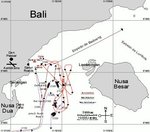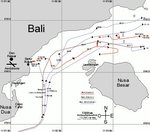syscom3
Pacific Historian
. This was another of battles where the allies had zero luck (yet again) in being able to strike a decisive blow against the IJN forces. Again the allies had to drink from the bitter dregs of defeat!
Battle of the Badoeng Strait
The fall of Bali and the naval battle of the Badoeng Strait 18 - 20 of February of 1942
By: Felipe C. Ramires
Strategic context
The island of Bali is considered to be one of the best tropical paradises of the Indonesian archipelago. Located in the Lesser Sundas archipelago, with the Indian Ocean to the south and the Flores Sea to the north, this small volcanic island of 5591 Km2 is situated only a few miles off the eastern coast of the island of Java. It gives any visitor an excellent exotic-tropical environment, very important traces of the ancient Indonesian Hindu civilisation, small and magnificent beaches like the Beach of Kuta and the warm waters of the Bali, Badoeng and Lombok Straits. However, most people would never imagine that in one day, those beaches would be the stage of the disembarkation of the Japanese invaders and that soon after these calm waters would be the scene of the second naval battle fought between the Allied forces (ABDA) and the Japanese strike forces, in the first phase of the Pacific Campaign.
After the Pearl Harbour attack on the 7th of December of 1941, all the Japanese armed forces initiated an expansion campaign to all Southeast Asia, Philippines and the Indonesian archipelago, an expansion that would be known as the Japanese "blitzkrieg". The recent and badly organised Allied force (ABDA), formed to put up some resistance to the Japanese tentacles, could do little or nothing to stop it and besides that it suffered heavy casualties in the air, land and sea. The Japanese ambition and the desperate necessity of getting raw materials (oil, rubber and timber), in abundance from the region, were the principal motivation that led the Japanese Empire to take this initiative, later crowned with success.
On the 10th of February 1942 the Japanese completed the conquest of the island of Borneo with the capture of Bandjarmasin and with the securement of an airfield at Balikpapan. Makassar and Kendari in the Celebes islands were taken respectively on the 8th and the 10th of February and they could give them excellent naval and aerial support bases. On the 14th of February another Japanese disembarkation occurred on the west coast of Sumatra Island, the oil refineries and the air base of Palembang secured in this island formed another strong support base for the next attacks. The island of Java, where the great part of the Allied forces were concentrated, was the main target and since it was already surrounded from the west and north it was needed to do it also by east. Bali then became involved in this strategic context and it was more then vital to the Japanese to take over the island to secure a final offensive with success.
Beyond the geographic proximity of Java, the island of Bali also interested the Japanese with the fact that there was one important airfield in Den Passar, the biggest city in the island. Even occupied by the Dutch it was more than essential to take the airfield intact because it could give an excellent capacity of aerial support and control in the involved zone. It would be easier for the Japanese to set off air raids to Soerabaja and to Tjilatjap, important Allied naval bases, and to the Allied airfields of Blimping, Perak and Madaen. The already taken airfields of the Borneo and Celebes islands could do the same function but due to the great distance and to the adverse climatic conditions the flight operations in these bases were much more limited. Bali offered much dryer weather and other favourable conditions to a continuous aerial support campaign. There was also the necessity of interception of the current Allied fighter flights from Australia to Java and with one fighter-interception force at Bali it would be much easier for the Japanese to block these fighter reinforcements. By the other side, the existence of such aerial support could give also, in certain forms, a good security for the Bali, Badoeng and Lombok Straits. The occupation of Bali was exclusively strategic and in spite of offering almost nothing to the development of the Japanese Empire it was more than essential it be captured.


